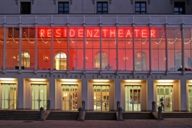
After the Second World War, the construction of the new Residenztheater on Max-Joseph-Platz square was the subject of some heated debates. Would it be possible to justify spending so much money during such difficult times?
Neither was the theatre’s modern architectural design to everyone’s tastes. After all, the new Residenztheater was to be given pride of place between the venerable Residenz palace and the classical Nationaltheater. This is the spot where its predecessor – the Alte Residenztheater (the Old Residence Theatre, also known as the Cuvilliés Theatre) – and its extravagant design had been instilling awe in electors and kings since the mid-1700s.
However, this jewel of rococo design failed to survive the bombing of the Second World War, so the city decided to build a new theatre over its foundations instead. The Cuvilliés Theatre was then reconstructed at a separate location in the Residenz palace in 1958.
When the Neue Residenztheater (New Residence Theatre) was completed in 1951, it did not take long for any initial criticism and doubts to be dispelled. The public fell in love with the building’s modern facilities and cutting-edge technology. Locals were particularly impressed by the fully equipped, versatile stage and excellent acoustics.
Nevertheless, a few safety issues began to appear in the 1980s, signalling that the once so modern building had begun to age. Between 1988 and 1991, the theatre therefore underwent a large-scale renovation using plans created by the architect Alexander Freiherr von Branca. In addition to some structural changes, like opening up the foyer’s ceiling between the ground and first floor, a few aesthetic amendments also took place: for instance, the main auditorium’s ceiling is now adorned with a Fred Thieler painting known as “Nachthimmel” (“Night Sky”), designed to represent the hall opening out into the skies.
In day-to-day life, the term Residenztheater is also used to refer to the entire Bavarian state theatre company, which goes by the name of Bayerische Staatschauspiel. With over 50 actors, it is one of the largest and most important traditional theatre companies in Germany. They also perform at the Cuvilliés Theatre and Marstall, both of which are in close proximity to the Residenz palace in the heart of Munich.
You can find an overview of the premieres of classical spoken theatre and major music theatres here.